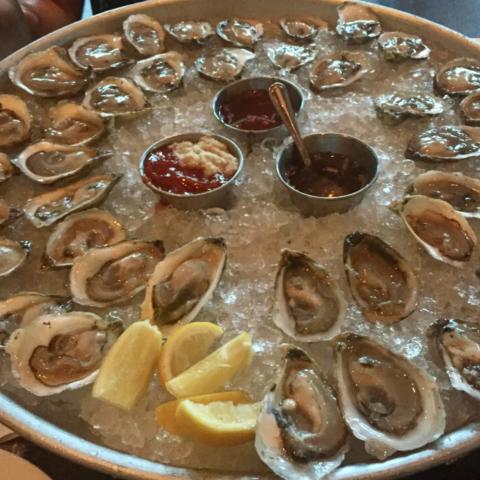Though infections by the bacterium Vibrio parahaemolyticus have increased in the Northeast, New Hampshire and Maine have avoided any Vibrio-linked illness. That could be because of New Hampshire’s groundbreaking policy preventing the import of oyster seed from areas affected by a virulent strain of Vibrio introduced from the Pacific, ST36. However, we don’t know exactly how risky importing seed from these areas is, and farmers could benefit from diversifying seed sources. Therefore, Cheryl Whistler, professor of molecular, cellular, and biomedical science at the University of New Hampshire, will investigate the actual risk of Vibrio contamination through seed transport, explore mitigation measures like salt relay and microbiome resistance, and improve detection of harmful Vibrio strains. Whistler’s work will help New Hampshire aquaculture continue growing, keep its product healthy, and inform future policy protecting New Hampshire waters from Vibrio pathogens.
Principle Investigator

Cheryl Whistler, Ph.D.
Professor, Molecular, Cellular, and Biomedical Sciences, University of New Hampshire
Cheryl.Whistler@unh.edu
Project Funding Cycle
2022-2023 NH Sea Grant Biennial Research Funding
Project Abstract
Although Vibrio parahaemolyticus, the leading cause of seafood-borne gastroenteritis world-wide, had caused infections from shellfish harvested in other US regions for decades, it rarely caused infections in the Northeast US (CDC 1999; DePaola et al., 2000; Daniels et al., 2000; Newton et al. 2012; Scallan et al., 2011). But this changed in 2012 when an invasive hypervirulent “strain” from the Pacific called sequence type 36 (ST36) caused gastroenteritis from contaminated oysters harvested in Long Island Sound (Newton et al., 2012; Martinez-Urtaza et al., 2017). ST36 overwintered and re-emerged in 2013 in aquaculture areas of NY and CT in the LIS, in Katama Bay (KB) of Martha’s Vineyard, and in Duxbury/Plymouth Bay in MA causing a large outbreak of 104 known cases reported in 13 US States (Newton et al., 2013). ST36 has remained extremely resilient in the Northeast and now causes recurrent infections requiring laborious and costly control measures that do not always prevent illnesses and subsequent harvest closures. How it was introduced into the region is still a matter of considerable debate, but most blame human activities such as unpermitted wet storage of Pacific shellfish or movement of ship ballast as a possible conveyor, rather than natural oceanic currents because significant geographic (continental) barriers thwart interoceanic movement (Marinez-Urtaza et al., 2013).
The ST36 strain has not been linked to any illnesses from oysters harvested in New Hampshire or Maine, but our ongoing work demonstrates that many non-native lineages from the Pacific and the Gulf of Mexico, and even lineages linked to illnesses in Maine have increased in prevalence in the Great Bay Estuary of New Hampshire over the last decade (Xu et al., 2015; Xu 2017). These population changes have occurred concurrently with warming estuary temperatures (Hartwick et al., 2019; Urquhart et al., 2016; Xu et al, 2015), but also a steadily growing aquaculture industry in NH and importation of seed from a variety of producers, including from areas contaminated with ST36. Because non-native pathogenic lineages could be translocated by movement of oyster seed, NH implemented a groundbreaking policy in 2018, aiming to reduce the chances of ST36 establishing in aquaculture sites by restricting movement of oyster seed from localities linked to ST36 illnesses. Growers may import seed stock from ME, but introduction of hypervirulent strains into ME production areas could have dire consequences to NH growers. As infections from some MA areas have recently declined, some growers have pressed for elimination of the policy. In direct consultation with NH growers and shellfish managers, we identified a critical need to 1) document the risks associated with oyster seed and its movement and 2) evaluate whether the remediation practice of “salinity relay” used on adult oysters could be adapted to an on-line system to reduce risk of pathogen contamination. As a mechanistic underpinning of both these questions, we seek to understand the temporality of oyster microbiome development and its association with Vibrios to gain insight into the vulnerability of oysters to contamination. This builds upon existing strengths and funded research by the Whistler team and will lay the foundation for future mechanistic studies. Finally, assessing contamination and its reduction requires accurate and sensitive methods. The FDA PCR-based V. parahaemolyticus enumeration methods are not specific and cross-detect variants of other Vibrio spp. and are unable to discriminate between ST36 and likely non-pathogenic strains that carry similar gene content. Therefore, we will 3) continue to improve assays for use in our region to provide useful information- a goal we are uniquely equipped to address due to our recent work developing patent-pending pathogen-specific assays for ST36. In this project we will balance these research initiatives to inform policy development by the state and provide contingencies to growers for acquiring safe seedstock and ensuring safe product.
Project News
